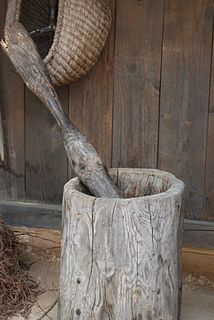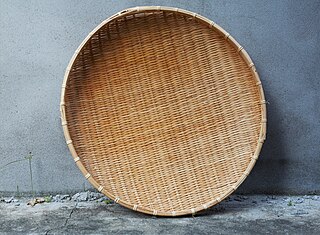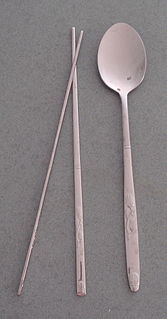 W
WA cleaver is a large knife that varies in its shape but usually resembles a rectangular-bladed hatchet. It is largely used as a kitchen or butcher knife intended for hacking through bone. The knife's broad side can also be used for crushing in food preparation.
 W
WA dolsot or gopdolsot is a small-sized piece of cookware or serveware made of agalmatolite, suitable for one to two servings of bap. In Korean cuisine, various hot rice dishes such as bibimbap or gulbap as well as plain white rice can be prepared and served in dolsot. As a dolsot does not cool off as soon as removed from the stove, rice continues to cook and arrives at the table still sizzling.
 W
WGamasot (가마솥), or simply sot (솥), is a big, heavy pot or cauldron used for Korean cooking.
 W
WJeolgu (절구) and gongi (공이) are a type of traditional Korean mortar and pestle set, used for pounding grains or tteok. They can be made with timber, stone, or iron. Jeolgu is a bowl-shaped vessel in which grains or tteok can be pounded, and gongi refers to either a pestle for a mortar or a stamper for a stamp mill.
 W
WOnggi is Korean earthenware, which is extensively used as tableware, as well as storage containers in Korea. It includes both unglazed earthenware fired near 600 to 700°C and pottery with a dark brown glaze fired at over 1100°C.
 W
WA rice cooker or rice steamer is an automated kitchen appliance designed to boil or steam rice. It consists of a heat source, a cooking bowl, and a thermostat. The thermostat measures the temperature of the cooking bowl and controls the heat. Complex rice cookers may have sensors and other components, and may be multipurpose.
 W
WSiru (시루) is an earthenware steamer used to steam grain or grain flour dishes such as tteok.
 W
WSokuri is a round, rimmed woven basket made of finely-split bamboo. It is used for straining washed grains, drying vegetables, or draining fried food in Korea.
 W
WSpoon and chopstick rest is a piece of tableware for resting a spoon and chopsticks without touching the table. In Korean cuisine context, it can be referred to as sujeo rest as sujeo is a paired set of spoon and chopsticks, which is very common in Korea.
 W
WSujeo (수저) is the Korean word for the set of eating utensils commonly used to eat Korean cuisine. The word is a portmanteau of the words sutgarak and jeotgarak. The sujeo set includes a pair of oval-shaped or rounded-rectangular metal chopsticks, and a long handled shallow spoon of the same material. One may use both at the same time, but this is a recent way to speed eating. It is not considered good etiquette to hold the spoon and the chopstick together in one hand especially while eating with elders. More often food is eaten with chopsticks alone. Sometimes the spoon apart from chopsticks is referred to as sujeo.
 W
WA ttukbaegi (뚝배기) is a type of oji-gureut, which is an onggi coated with brown-tone ash glaze. The small, black to brown earthenware vessel is a cookware-cum-serveware used for various jjigae (stew), gukbap, or other boiled dishes in Korean cuisine. As a ttukbaegi retains heat and does not cool off as soon as removed from the stove, stews and soups in ttukbaegi usually arrive at the table at a bubbling boil.